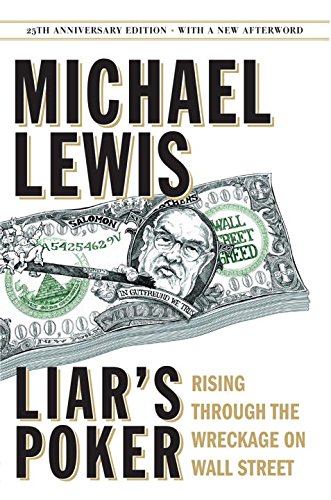Liar's Poker Review
Preamble
As this is my first book review, I will talk a bit about the format I intend to follow. The “reviews” won’t so much be an evaluation of the book itself. I don’t intend on giving a grade to individual books but I will make remarks as to how the book compares to other similar works. For example, as I have been reading lots of Michael Lewis, I will compare his books to each other so that someone who has read his other works and sitting on the fence of buying another book can more easily decide.
The reason that I think giving a score to the books is pointless is because I only intend on reading good books. At least, books that I know that I will enjoy. Instead, I will be focusing on giving a brief synopsis of the book. Probably at the chapter level for non fiction and whatever makes sense for fiction. I will then interleave my thoughts into these summarizations. This will serve two purposes: one, to give everyone a better look at the content. Two, to provide the readers with - hopefully - entertaining commentary that justifies you spending time on this blog. Some reviews will be better than others, so feel free to skip the ones that don’t interest you.
Finally, I will be including Amazon affiliate links if you wish to purchase the book. I think I get anywhere from 4-5% of the sale depending on the format of the book you buy. Basically, if a couple of people buy the book, it pays for my next book. I hope it is also convenient for you.
Review

Disclaimer: Amazon Affiliate Link
Let me first apologize to Michael Lewis for not taking proper notes during reading his book for this review to do it justice. That being said, there is a reason this book launched him into limelight - this is a must read. Often described as the bible or the de facto guide to Wall St., this book outlines Lewis’ experience of working as a bond salesman for Salomon Brothers during the 80’s. Although he intended to expose the dark side of Wall St. and discourage its behaviour, it is now treated by “finance bros” in undergraduate colleges everywhere on how to act.
The book starts by outlining Lewis’ time at Princeton as a art history major and how he comes into working on Wall St. which is in itself an interesting story. It then goes into where the book gets its title, Liar’s Poker. Liar’s poker is a game that is/was popular among finance people that is played between two people that requires taking a dollar bill and looking at the serial code. What follows is a series of bids of one person saying “I have three 1’s” and the players take turns of either increasing either number (three 2’s or four 1’s). The reason why this game is important is because the CEO of Salomon Brothers, John Gutfreund, challenges challenges star trader and reputed best player of the game, John Meriwether for $1 Million. In perhaps what can be described as the best play ever in the game of Liar’s Poker, Meriwether says he will only play for $10 Million to which his boss backs down.
The book then goes deep into the culture of investment bankers at the time. As you can imagine, it includes many amusing yet saddening stories of how they acted and intentionally gouged their customers. What I really like about Lewis is his honesty in not hiding his own intentional actions (although he, unlike the others, have a chance to express remorse). Some examples of stories include: how certain teams formed tribes within the firm and how they each developed their own set of rituals, Lewis’ account of being forced by his superiors to intentionally offload bad assets to one of his richest customers, the pranks they used to play on each other that 99% of the population could not even afford to partake in once.
As a finance person, but probably the opposite for the average reader, the most interesting part for me was the history of how Lewis Ranieri spearheaded the creation of Mortgage Backed Securities (MBS). These are essentially a collection of mortgages that are pooled together to generate payments similar to bonds and hence why Michael Lewis was exposed to it first hand; he was a bonds salesman. The reason why this is interesting to me was that it is a firsthand account into the creation of something that comes back to haunt America and the World in 2008 and subject matter for Michael Lewis’ book and Oscar nominated film, The Big Short. The difference between MBS’s and normal bonds, they are much riskier. To illustrate why these should be interesting to everyone:
American pension funds controlled about six hundred billion dollars’ worth of assets in June 1983, when the first [MBS] was issued by Freddie Mac [some US government agency designed to buy mortgages and bundle them so that Americans can buy more homes]. None of the money was money was invested in home mortgages. By the middle of 1986 they held about thirty billion dollars’ worth of [MBS’s], and that number was growing fast.
To put it succinctly, the creation of MBS’s allowed pension funds (think of your parent’s pension fund or your government’s pension fund that you have to pay into) to take on unprecedented risk while paying these salesmen millions. Think about that, $30 billion in 3 years generates a lot of commission fees.
The book then goes into the history of high yield (junk) bonds with a focus on Michael Milken as he is one of their main developers. At the very least, he is the first guy to truly recognize their potential by using them to fund leveraged buyouts. That is where you sell high yield bonds to someone who will fund, usually a collection, people to take over ownership of a company through buying all the stock. Then, while in charge, they will make the company buy all the stock back at a higher price than what they paid for it. Lots of restructuring (read: firing) at the company occurs as a guise to cut costs. This allowed guys like Ronald O. Perelman to make his career as a corporate raider (the guys who go in and restructure the company) which is also discussed in the book. Ronald O. Perelman is now so rich that his name is on the under construction Performing Arts Center at the World Trade Center which I walk by everyday on my way to work. This is also in the news lately as Elon Musk plans to takeover Tesla using the same tactic. However, Elon, unlike bankers, potentially may have potentially incriminated himself by tweeting about it. (Side bar: inserting myself into the review and shooting shots at Musk, best post ever). My favourite quote from this section was Milken teaching a class during Lewis’ training:
On these occasions he liked, for dramatic effect, to demonstrate how hard it actually is to put a large company into bankruptcy. That forces interested in keeping a large company afloat, he argued, are far greater than those that wish to see it perish. He’d present the students with the following hypothetical situation. First, he’d say, let’s locate our major factory in an earthquake zone. Then let’s infuriate our unions by paying the executives large sums of money while cutting wages. Third, let’s select a company on the brink of bankruptcy to supply us with an essential irreplaceable component in our production line. And fourth, just in case our government is tempted to bail us out when we get into trouble, let’s bribe a few indiscreet foreign officials. That, Milken would conclude, is precisely what Lockheed had done in the late 1970s.
To close, I really enjoyed this book and highly recommend it to finance people. I hope that you don’t get excited by the raucous tales of bankers in the 80’s for which Lewis’ has plenty, but rather as a sobering note of how the financial system works. That being said, this book is a wonderful combination of entertaining stories of American greed with a primary account of the history of many financial concepts still in use today.
If you want to buy this book and support my site, here is my Amazon affiliate link: Liars Poker (25th Anniversary Edition): Rising Through the Wreckage on Wall Street (25th Anniversary Edition)
Next Up: The Money Culture by Michael Lewis
Cheers,
Zach

